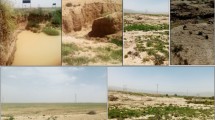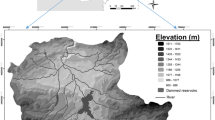Abstract
The present study aims to estimate the annual soil loss in the Soummam watershed in the northeast of Algeria, using the Revised Universal Soil Loss Equation (RUSLE), geographic information system (GIS), and remote sensing (RS). RUSLE model has been used for modelling the main factors involved in erosive phenomena. The Soummam watershed covers a surface area of 9108.45 km2 of irregular shape, northeast —southwest towards southeast. It is characterized by an altitude varying between 2 m in the northeast and 2308 m in the northwest. Results showed that the average erosivity factor (R) is 70.64 (MJ·mm)/(ha·h·year) and the maximum value reaches 140 (MJ·mm)/(ha·h·year), the average soil erodibility factor (K) is 0.016 (t·h·ha)/(MJ·ha·mm) and maximum values reach 0.0204 (t·h·ha)/(MJ·ha·mm) in the southeast regions of the watershed, the average slope length and steepness factor (LS) is 9.79 and the mean C factor is estimated to be 0.62. Thematic maps integration of different factors of RUSLE in GIS with their database, allowed with a rapid and efficient manner to highlight complexity and factors interdependence in the erosion risk analyses. The resulting map for soils losses, with an average erosion rate of 6.81 t/(ha·year) shows a low erosion (<7.41 t/(ha·year)) which covers 73.46% of the total area of the basin, and a medium erosion (7.42 to 19.77 t/(ha·year)), which represents 17.66% of the area. Areas with extreme erosion risk exceeding 32.18 t/(ha·year) cover more than 3.54% of the basin area. The results can certainly aid in implementation of soil management and conservation practices to reduce the soil erosion in the Soummam watershed.
Similar content being viewed by others
Explore related subjects
Discover the latest articles and news from researchers in related subjects, suggested using machine learning.References
Abu Hammad A (2011) Watershed erosion risk assessment and management utilizing revised universal soil loss equation-geographic information systems in the Mediterranean environments. Water and Environment Journal 25: 149–162. https://doi.org/10.1111/j.1747-6593.2009.00202.x
Agapiou A. and Hadjimitsis DG (2011) Vegetation Indices and Field Spectroradiometric Measurements for Validation of Buried Architectural Remains: Verification under Area Surveyed with Geophysical Campaigns. Journal of Applied Remote Sensing 5: 1–15. https://doi.org/10.1117/1.3645590
Allili Ch, Laignel B, Adjeroud N, et al. (2015) Particulate Flow at the Mouth of the Soummam Watershed (Algeria). Environmental Progress & Sustainable Energy 35 (1): 204–211. https://doi.org/10.1002/ep.12210
Arnoldus HMJ (1980) An approximation of the rainfall factor in the Universal Soil Loss Equation. In: De Boodt M, Gabriels D (Eds.), Assessment of Erosion. Wiley, Chichester, UK 127–132.
Belasri A and Lakhouili A (2016) Estimation of soil erosion risk using the Universal Soil Loss Equation (USLE) and Geo-Information Technology in Oued El Makhazine Watershed, Morocco. Journal of Geographic Information System 8: 98–107. https://doi.org/10.4236/jgis.2016.81010
Benhamiche N, Sahi L, Tahar S, et al. (2016) Spatial and temporal variability of groundwater quality of an Algerian aquifer: The case of SoummamWadi. Hydrological Sciences Journal 61: 775–792. https://doi.org/10.1080/02626667.2014.966723
Berghout A, Meddi M (2016) Sediment transport modelling in wadi Chemora during flood flow events. Journal of Water and Land Development 31: 23–31. https://doi.org/10.1515/jwld-2016-0033
De Jong SM, Brouwer LC, Riezebos HT (1998) Erosion hazard assessment in the Peyne catchment, France. Working paper DeMon-2 Project, University of Utrecht.
Efthimiou N, Psomiadis E (2018) The Significance of Land Cover Delineation on Soil Erosion Assessment. Environmental Management 62 (2): 383–402. https://doi.org/10.1007/s00267-018-1044-3
Hermassi T, Cherif MA, Habaieb H (2014) Solid transport study at the Merguellil watershed, central Tunisia: case study of Ettiour and Rajela watersheds. La Houille Blanche 4: 88–96. https://doi.org/10.1051/lhb/2014043
Hudson NW (1981) Soil conservation. Batsford, UK, 2nd edition.
Hyeon SK, Julien PY (2006) Soil erosion modeling using RUSLE and GIS on the IMHA watershed. Water Engineering Research 7 (1): 29–41.
Jah MK, Paudel RC (2010) Erosion predictions by empirical models in a mountainous watershed. Journal of Spatial Hydrology 10: 89–102.
Jiang Z, Huete AR, Chen J, et al. (2006) Analysis of NDVI and scaled difference vegetation index retrievals of vegetation fraction. Remote Sensing of Environment 101: 366–378. https://doi.org/10.1016/j.rse.2006.01.003
Khali Issa L, Ben Hamman Lechhab K, Raissouni A, et al. (2016) Quantitative Mapping of Soil Erosion Risk Using GIS/USLE Approach at the Kalaya Watershed (North Western Morocco). Journal of Materials and Environmental Science 7 (8): 2778–2795. (In French)
Kinnell PIA (2001) Slope length factor for applying the USLE-M to erosion in grid cells. Soil & Tillage Research 58: 11–17. https://doi.org/10.1016/S0167-1987(00)00179-3
Kustas WP, Schmugge TJ, Humes KS, et al. (1993) Relationships between evaporative fraction and remotely sensed vegetation index and microwave brightness temperature for semiarid rangelands. Journal of Applied Meteorology 32: 1781–1790. https://doi.org/10.1175/1520-0450(1993)032<1781:RBEFAR>2.0.CO;2
Mazour M, Roose E (2002) Influence de la couverture végétale sur le ruissellement et l’érosion des sols sur parcelles d’érosion dans des bassins versants du Nord-Ouest de l’Algérie. Bulletin Réseau Erosion 21: 320–330. (In French)
McCool DK, Brown LC, Foster GR, et al. (1987) Revised slope steepness factor for the Universal Soil Loss Equation. Transactions of the American Society of Agricultural Engineers 30: 1387–1396. https://doi.org/10.13031/2013.30576
McCool DK, Foster GR, Mutchler CK, et al. (1989) Revised slope length factor for the universal soil loss equation. Transactions of the American Society of Agricultural Engineers 32(5): 1571–1576. https://doi.org/10.13031/2013.31192
Meddi M and Toumi S (2017) Spatial variability and cartography of maximum annual daily rainfall under different return periods in the North of Algeria. International Journal of Hydrology Science and Technology 7 (1): 77–102. https://doi.org/10.1007/s11629-014-3084-3
Milward AA, Mersy JE (1999) Adapting RULSE to model soil erosion potential in a mountainous tropical watershed. Catena (38): 109–129. https://doi.org/10.1016/S0341-8162(99)00067-3
Mokhtari EH (2017) Impact de l’érosion hydrique sur l’envasement du barrage Ghrib. Thèse de doctorat en sciences, Université Hassiba Ben Bouali, Chlef, Algérie. (In French)
Prasannakumar V, Vijith H, Abinod S, et al. (2012) Estimation of soil erosion risk within a small mountainous sub-watershed in Kerala, India, using Revised Universal Soil Loss Equation (RUSLE) and geo-information technology. Geoscience Frontiers 3 (2): 209–215. https://doi.org/10.1016/j.gsf.2011.11.003
Panagos P, Meusburger K, Alewell C, et al. (2012) Soil erodibility estimation using LUCAS point survey data of Europe. Environmental Modelling & Software 30: 143–145. https://doi.org/10.1016/j.envsoft.2011.11.002
Panagos P, Ballabio C, Borrelli P, et al. (2015a) Rainfall erosivity in Europe. Science of the Total Environment 511: 801–814. https://doi.org/10.1016/j.scitotenv.2015.01.008
Panagos P, Borrelli P, Meusburger K (2015b) A new European slope length and steepness factor (LS-factor) for modeling soil erosion by water. Geosciences 5: 117–126. https://doi.org/10.3390/geosciences5020117
Panagos P, Borrelli P, Meusburger K, et al. (2015c) Modelling the effect of support practices (P-factor) on the reduction of soil erosion by water at European scale. Environmental Science & Policy 51: 23–24. https://doi.org/10.1016/j.envsci.2015.03.012
Panagos P, Borrelli P, Meusburger C, et al. (2015d) Estimating the soil erosion cover-management factor at European scale. Land Use Policy 48(C): 38–50. https://doi.org/10.1016/j.landusepol.2015.05.021
Probst JL, and Suchet AP (1992) Fluvial suspended sediment transport and mechanical erosion in the Maghreb (North Africa). Hydrological Sciences Journal 37: 621–637. https://doi.org/10.1080/02626669209492628
Renard KG, Foster GR, Weesies GA, et al. (1991) RUSLE: Revised Universal Soil Loss Equation. Journal of Soil and Water Conservation 46(1): 30–33.
Renard KG, Foster GR, Weesies GA, et al. (1997) Predicting rainfall erosion by water: A guide to conservation planning with the revised universal soil loss equation (RUSLE). Agricultural handbook, USDA. 703.
Rouse JW, Haas RH, Schell JA, et al. (1973) Monitoring vegetation systems in the Great Plains with ERTS. In: 3rd ERTS symposium, Washington, DC. NASA SP-351.
Sadiki A, Bouhlassa S, Auajjar J, et al. (2004) Use of GIS for the Evaluation and Mapping of Erosion Risk by the Universal Soil Loss Equation in the Eastern Rif (Morocco): case study of Boussouab watershed. Bulletin de l’Institut Scientifique, Rabat, section Sciences de la Terre 26: 69–79. (In French)
Sepuru TK, Dube T (2018) An appraisal on the progress of remote sensing applications in soil erosion mapping and monitoring. Remote Sensing Applications: Society and Environment 9: 1–9. https://doi.org/10.1016/j.rsase.2017.10.005
Simonneaux V, Cheggour A, Deschamps C, et al. (2015) Land use and climate change effects on soil erosion in a semi-arid mountainous watershed (High Atlas, Morocco). Journal of Arid Environments 122: 64–75. https://doi.org/10.1016/j.jaridenv.2015.06.002
Stone RP, Hilborn D (2000) Equation universelle des pertes en terre (USLE). Soil Erosion. Water Resources Management 16: 447–467. (In French)
Touaibia B (2010) Problematic of erosion and transport of solids in Northern Algeria. Sécheresse 1: 1–6. (In french)
Toumi S, Meddi M, Mahé G, et al. (2013) Cartographie de l’érosion dans le bassin versant de l’Oued Mina en Algérie par télédétection et SIG. Hydrological Sciences Journal 58(7): 1542–1558. (In French) https://doi.org/10.1080/02626667.2013.824088
Turki I, Laignel B, Benhamiche N, et al. (2016) Hydrological variability of the Soummam watershed (Northeastern Algeria) and the possible links to climate fluctuations. Arabian Journal of Geosciences 9: 477. https://doi.org/10.1007/s12517-016-2448-0
Wischmeier WH, Smith DD (1978) Predicting rainfall erosion losses — a guide to conservation planning. Agriculture handbook, USDA. 537.
Wynants M, Solomon H, Ndakidemi P, et al. (2018) Pinpointing areas of increased soil erosion risk following land cover change in the Lake Manyara catchment, Tanzania. International Journal of Applied Earth Observation and Geoinformation 71: 1–8. https://doi.org/10.1016/j.jag.2018.05.008
Xu YQ, Shao XM, Kong XB, et al. (2008) Adapting the RUSLE and GIS to model soil erosion risk in a mountains karst watershed, Guizhou Province, China. Environmental Monitoring Assessement 141: 275–286. https://doi.org/10.1007/s10661-007-9894-9
Zhang H, Yang Q, Li R, et al. (2013) Extension of a GIS procedure for calculating the RUSLE equation LS factor. Computers & Geosciences 52: 177–188. https://doi.org/10.1016/j.cageo.2012.09.027
Acknowledgement
The authors acknowledge the Personnel of the National Agency of Water Resource (NAWR — Algiers) and their respective Universities for their assistance.
Author information
Authors and Affiliations
Corresponding author
Electronic Supplementary Material
11629_2018_5325_MOESM1_ESM.pdf
Mapping of surface water erosion potential using the Revised Universal Soil Loss Equation in the Soummam watershed, Northeast Algeria
Rights and permissions
About this article
Cite this article
Sahli, Y., Mokhtari, E., Merzouk, B. et al. Mapping surface water erosion potential in the Soummam watershed in Northeast Algeria with RUSLE model. J. Mt. Sci. 16, 1606–1615 (2019). https://doi.org/10.1007/s11629-018-5325-3
Received:
Revised:
Accepted:
Published:
Issue Date:
DOI: https://doi.org/10.1007/s11629-018-5325-3
Keywords
Profiles
- Elhadj Mokhtari View author profile




